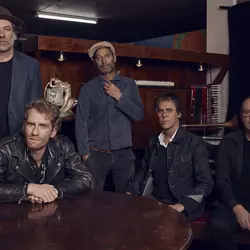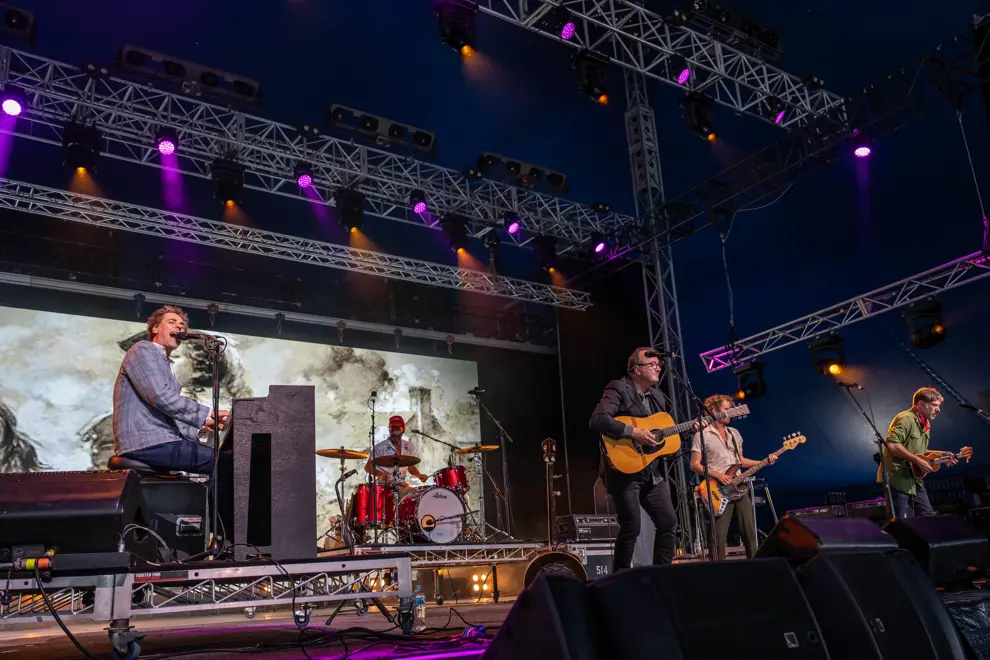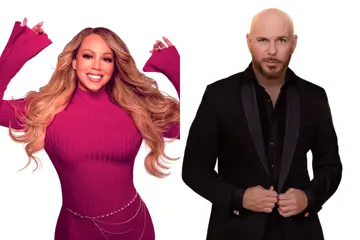 The Whitlams, Black Stump Band
The Whitlams, Black Stump BandAs alt-country projects go, it has to be said that The Whitlams Black Stump is already a resounding success – firstly because they have perfectly captured the essence of The Whitlams’ original repertoire, but even more so because they were able to draw a festival crowd in the early hours of a Sunday afternoon.
At a festival full of variety—from classic rock to virtuosic acoustic guitar to dancing mummies—The Whitlams Black Stump managed to stand out in several ways.
The first trademark was their propensity for writing songs with interesting lyrics that told unique, fascinating stories. Having released their new album, Kookaburra, just weeks prior, the band relished the opportunity to play each of its tracks live in front of an enthusiastic crowd. Your Boyfriend’s Back In Town was an early hit; its ambling country style and easy vocal harmonies perfectly fit the hazy afternoon vibes.
The semi-eponymous tune known as No Aphrodisiac (Black Stump) would have been memorable enough for its lyrics alone, but nothing could have been more effective in bringing it to life than a stand-out brilliant banjo solo.
As far as storytelling goes, though, it would have been hard to top a tune “about a meth lab” – a phrase that made for an intriguing introduction to the track Nobody Wants To Be You. The ambling pace, playful, jazzy piano melodies and harmonic bursts made it a joyful, somewhat nostalgic listening experience for the crowd.
There was even a story to be told about the experience of waking up in Redfern, Sydney, on Grand Final Day, September 1970 – something that some members of the crowd likely remembered first-hand. A country slow dance accompanied the lyrics.
The set doubled as a history lesson in many ways, with songs about Ned Kelly’s sister Kate and titles like The Day John Sattler Broke His Jaw. As if the lyrics weren’t intriguing enough, the band did what they could to make the show an interesting visual spectacle – from their broad gesticulations (somehow simultaneous with the playing of instruments) to their fascinating backdrop animations, complementing the old-time stories.
This brings us to the second key observation, one that separates the wheat from the chaff in the live music scene: They were able to create playful energy on the stage, even without the luxury of free movement—the result of bulky instruments and limited space. Half of this came down to endearing storytelling panache and the ability to intrigue without gimmicks.
“On a long tour, you can have good times and camaraderie as well as dark times and trouble,” quipped charismatic frontman Tim Freedman – and while the trouble may or may not have been very real, it seemed that none of it had muddied their vibe on stage. They seemed like any crew of old-time friends.
Later in the set, he would tell the crowd, “I wanted Fallen Leaves to be a duet with Dolly Parton, but she wasn’t available, so we went down the line of all the other female country singers, but we got no bites, so instead we’ve got Oliver Thorpe doing harmonies.”
The other half was about the right vibes in individual songs – a perfect example being Witness Protection Scheme, the penultimate track on the new album. It brought out the best of the eclectic frontman’s stagecraft, inspiring dramatic gestures and animation even while both hands were busy on the keys. All the band members were in on the rhythm, and the crowd received and multiplied it beautifully.
The last and most endearing thing worth noting about the band was their humility. Despite (and perhaps, in some way, because of) their 137 years of combined touring experience, they had no expectations but gratitude for the crowd watching on.
“We weren’t sure if anyone would show up,” they said to a packed-out tent towards the end of the set. About bands like this one, one thing is certain: as long as there are genre purists and die-hard fans, there will always be a market for old classics brought back from the second-hand pile and made new again.






